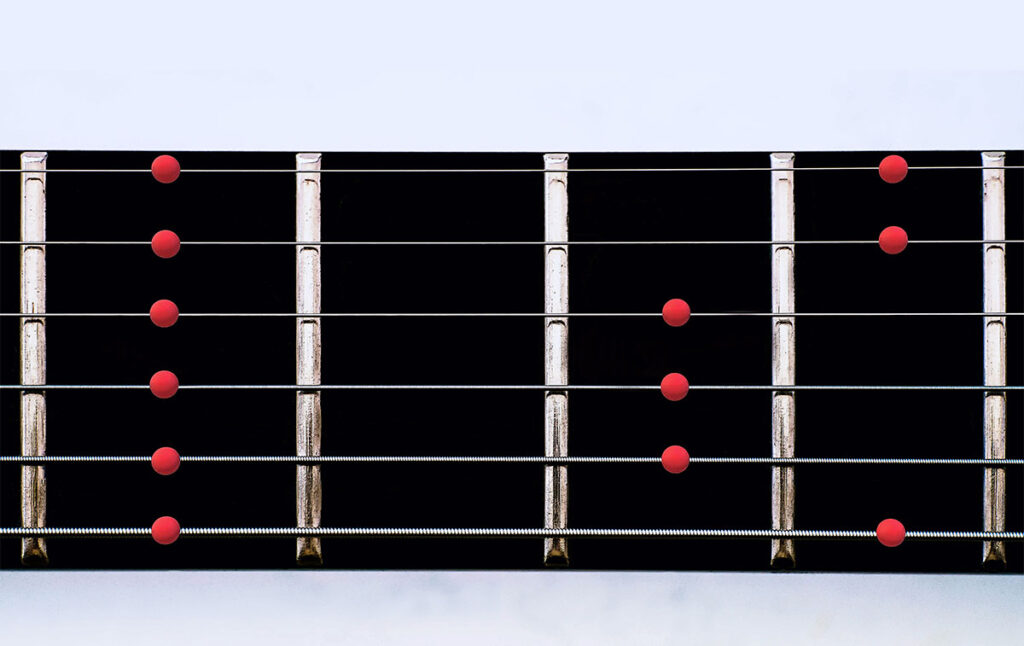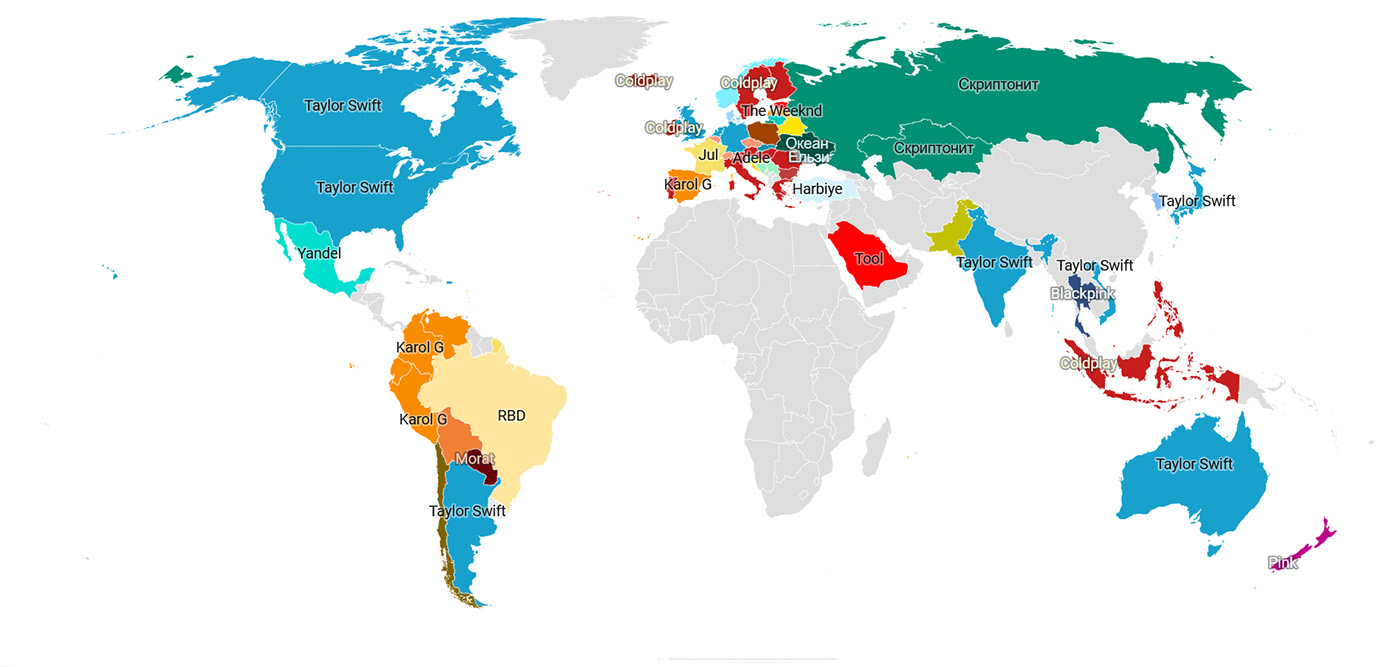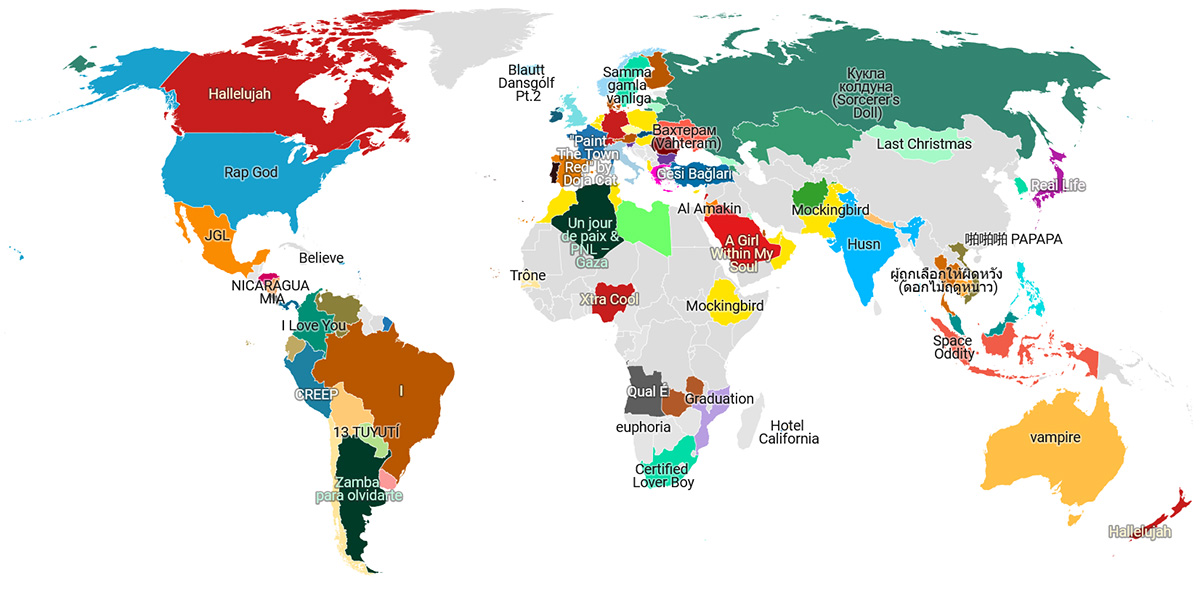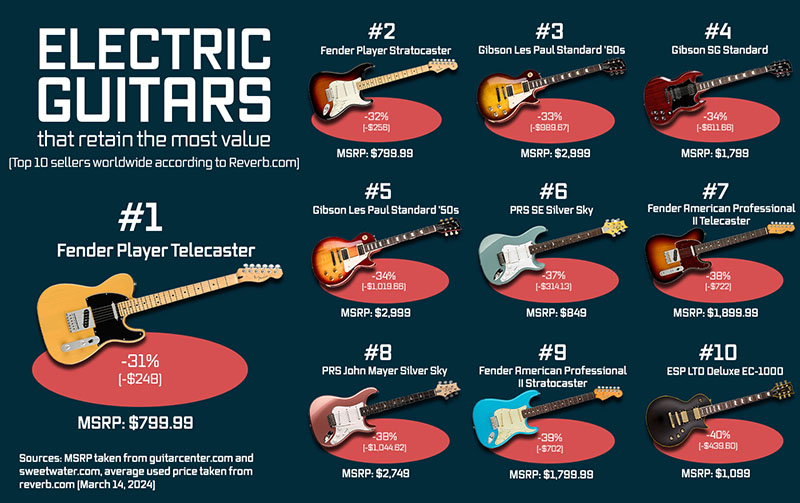A pentatonic scale (Greek πέντα, penta, "five") is a musical scale consisting of five notes.
Pentatonic scales are found in almost all musical cultures, from many types of folk music (e.g., Celtic music, Hungarian folklore, Albanian folklore, Indonesian gamelan, or Andean Huayno chants) to West African music and its African-American offshoots such as spirituals, jazz, blues, and especially rock. The pentatonic scale is also frequently used in classical music, e.g. in numerous compositions by Claude Debussy.
There are two basic types of pentatonic scales: the major pentatonic and the minor pentatonic. Both consist of five notes, but the distances between the notes are different.
In Western music, the major pentatonic scale refers to the notes 1, 2, 3, 5, and 6 of a major scale. For example, in C major, these would be the notes C, D, E, G, and A.

The minor pentatonic scale consists of the notes 1, 3, 4, 5 and 7 of the natural minor scale. In A minor, these would be the notes A, C, D, E and G.

Types of pentatonic scales
The pentatonic scales known in Western tempered music are all anemitonic, i.e. without semitones and with only five steps.
Major and minor pentatonic
Thus, the classical pentatonic scale is characterized not only by the absence of semitones, but also by the fact that any of the five notes can be the final (and tonic) note. Thus, it is not correct to distinguish between a major and a minor pentatonic scale, but it is obvious how the two keys are included in the pentatonic scale.
The classic way to construct a pentatonic scale is to take five consecutive notes from the circle of fifths: for example, C, G, D, A, and E, which form a C pentatonic in reverse order. As you can see, these are the same notes as in the A minor pentatonic, just in a different order.
Examples
Pentatonic scales are widely used in traditional songs and folk music, as mentioned above. A song whose entire melody is based on a pentatonic major scale is the folk song Oh! Susanna by Stephen Foster or the Christian hymn Amazing Grace. An example in a minor key is the traditional Canadian song Land of the Silver Birch.

By loading the video, you accept YouTube's privacy policy.
Learn more
The pentatonic scale (and its analogous six-note blues scale) is also widely used in jazz: Examples include the opening melody of Duke Ellington's In a Sentimental Mood or the melody of I Got Rhythm, a well-known standard by George Gershwin.
In contemporary music, it was used by Paolo Conte in the song Aguaplano from the 1987 album of the same name.
In classical music, there are numerous examples besides the aforementioned Debussy:
- Etude op. 10 No. 5 in G♭ Major - On the black keys by Fryderyk Chopin: The whole melody is played with the right hand on the G♭ pentatonic (on the black keys).
- The "New World" Symphony and the "American" String Quartet in F Major by Antonín Dvořák: Both have a theme based largely on pentatonic scales and are probably inspired by Indian songs and African-American spirituals.
- Madama Butterfly and Turandot by Giacomo Puccini: Both works strongly allude to Japanese and Chinese sounds through the frequent use of pentatonic scales.
- Laideronette, Emperatrice des Pagodes, a movement from Ma Mère l'Oye by Maurice Ravel: This piece uses quarter-tone harmony on a pentatonic scale.
Because of the "oriental" feeling that pentatonic melodies convey, especially when harmonized in fourths, they are often used by composers of classical music (e.g. in the aforementioned works Madama Butterfly and Turandot) and in films to create oriental or other unusual moods.
Also interesting: What is counterpoint (music theory)? Definition, classification and application
The pentatonic system
Musicologist Constantin Brăiloiu believes that the pentatonic scales found in music around the world are not just a kind of scale, but a "pentatonic system" that exists independently of or before other musical systems.
Pentatonic scales have five notes divided into two groups, one with three notes and one with two notes. For example, in the G pentatonic we have one group with the notes G, A, B and another group with the notes D and E. Brăiloiu calls the group of three notes "pyknon", which means "dense" or "frequent" in ancient Greek.

The pyknon in the G pentatonic is made up of the notes G, A, B. It is particularly important because it has a sequence of notes that differ by one tone each. The pyknon is the main reference point for the listener.
In music, there are also notes that do not belong to the pentatonic scale. These notes are often called passing notes and often have an uncertain pitch. Brăiloiu compares them to the Chinese musical term "pien", which means "embellishment".
These passing notes are often less precise in pitch and are influenced by either consonance or attraction to neighboring notes.
In Western music, consonance has prevailed, but in other musical systems there are other solutions, such as adaptation to intermediate tones.
If we assign numbers to the notes of the "pentatonic system" that correspond to the notes of the diatonic scale, there are five main notes and additional "secondary notes" that are played less often because they sound more exciting.
For example:
| Pyknon | Pien | Pien | ||||||
| G | A | H | C | C♯ | D | E | F | F♯ |
| I Degree | II Degree | III Degree | V Degree | VI Degree | ||||
On these degrees (which, unlike the diatonic modes, have a relative functional indifference, i.e. do not exert any harmonic or melodic stimuli) it is thus possible to construct various modes which, according to Brăiloiu, justify the existence of a pentatonic musical system.
| Level | Scale (example in G) | ||||
| I ( major ) | G | A | H | D | E |
| II | A | H | D | E | G |
| III | H | D | E | G | A |
| V | D | E | G | A | H |
| VI ( minor ) | E | G | A | H | D |
Research in ethnomusicology seems to show that these principles apply to many cultures: Pentatonic systems are found in Chinese, African, and Eastern European music.
Pentatonic scales in different musical cultures
With non-tempered music systems, it is difficult to define the exact frequency ratios used in different musical cultures.
For example, if we assume that the pentatonic scale is derived from the Pythagorean scale by a sequence of right fifths (principle of the circle of fifths), then the frequency ratios between the different notes of the pentatonic scale (if we consider the ratio between the highest and the lowest note) are: 9/8 - 9/8 - 32/27 - 9/8 - 32/27. On the other hand, if we consider the scale as derived from the natural scale, we get 9/8 - 10/9 - 6/5 - 10/9 - 6/5.
Let me explain this a little more: The sound you hear when you strike a string on an instrument or when you sing has a certain frequency. This frequency is measured in hertz (Hz) and is equal to the number of vibrations the string or your vocal cords make per second.
For example, if you have one sound with a frequency of 200 Hz and another with a frequency of 300 Hz, then the ratio between the two sounds is 3/2 (because 300 divided by 200 equals 1.5 or 3/2).
These ratios are important because they determine how the tones sound together. Tones whose frequencies have simple ratios (like 2/1 or 3/2) usually sound harmonious together, while tones with more complex ratios often sound dissonant or "scratchy".
It is therefore very difficult to determine the exact relationship between the tones of the different musical systems, and the Western listener always tends to assign the tones to the tempered system.
The importance of the pentatonic in Western classical music
In the early days of Western classical music, the pentatonic scale played an important role, even if it was not explicitly emphasized. It was firmly rooted in the traditional heptatonic church keys and was used in early chorale melodies. With the establishment of the major-minor tonality, however, it lost importance.
It was not until the Romantic period, when interest in folk, non-European and indigenous forms of music was revived, that the pentatonic came to the fore again. It was appreciated as an independent tonal system with a special timbre. Composers adapted or imitated pentatonic themes from folk music, whether from their own nation or from exotic cultures.
For example, the pentatonic can be heard in the main motive of the "Morning Mood" from Peer Gynt Suite by Edvard Grieg or in the theme of the Largo movement of the 9th Symphony and String Quartet No. 12 by Antonín Dvořák.

By loading the video, you accept YouTube's privacy policy.
Learn more

Some composers used the pentatonic to expand, alienate, or enrich their major-minor harmonies. It can be found, for example, in Franz Liszt's "Au bord d'une source", in Frédéric Chopin's Etude op. 10 No. 5 in G flat major, which is played entirely on the black keys of the piano, and in Giacomo Puccini's operas "Madam Butterfly" and "Turandot".
In the musical movement known as Impressionism and among some 20th-century composers, the pentatonic was finally recognized as an independent form of tonality that could shape entire pieces or passages of music. Examples include Claude Debussy's "Arabesque No. 1," which was inspired by his encounter with Javanese and Balinese gamelan music at the Paris World's Fair in 1889, Maurice Ravel's "Passacaille" from his Piano Trio, and "Laideronnette" from "Ma Mère l'Oye." Béla Bartók's "The Miraculous Mandarin" and several pieces from his "Microcosmos," Susanne Hinkelbein's "Economia de Tahuantinsuyu" from her Latin America cycle, and Igor Stravinsky's "The Nightingale."
Contemporary composer Lou Harrison went a step further and explored new pentatonic scales in some of his works.
East
As already mentioned, the ethnomusicological development of scales led on the one hand to consonance and thus to the diatonism typical of Western music, and on the other hand to rational solutions in which "the step is placed in the middle of the interval to be filled".

By loading the video, you accept YouTube's privacy policy.
Learn more
This led to balanced pentatonic scales in which the pitches are roughly evenly distributed across the octave, such as the anemitonic pentatonic scale known as slendro, which is typical of the music of Java and Bali.

A similarly rationalistic attitude probably led to the equalization of the octave into seven roughly equal steps, from which - in Thailand - the usual pentatonic scale was extracted (facilitating transposition to fixed-tuned instruments such as the xylophone).
The pentatonic scale is the basis of Chinese and Mongolian music. In particular, the five modes obtained by playing the pentatonic scale from a different degree are widely used in China; these diaoshi modes are: gong, shang, jue, zhi and yu.
| Level | Diaoshi | Scales | ||||
| I | Gong | G | A | H | D | E |
| II | Shang | A | H | D | E | G |
| III | Jue | H | D | E | G | A |
| V | Zhi | D | E | G | A | H |
| VI | Yu | E | G | A | H | D |
Japanese music also uses a similar system: the fundamental notes of the Japanese shakuhachi flute form a pentatonic minor scale.
The Yo scale is used in Japanese Buddhist Shōmyō chants and in imperial Gagaku music. This scale type is nothing more than the fourth mode of an anemitonic pentatonic major scale, e.g. the D yo scale, which corresponds to the Chinese Diaoshi zhi scale:

America
The pentatonic minor scale is often used in folk songs of the North American Appalachian culture (the area from New York southward to Alabama and Georgia).
The folk songs of the Blackfoot Indians are often based on pentatonic scales. And pentatonic scales (major and minor) form the basis of Andean music, such as the traditional Huayno dances.
Jazz
Western classical and tonal jazz harmony is essentially based on chords characterized by intervals of thirds. When John Coltrane and Miles Davis introduced modal improvisation (Kind of Blue, 1959 and My Favourite Things, 1960), the use of pentatonic scales proved very important because the melodies built on these scales are inherently ambiguous, oscillating between the relative modes of major (Ionian, Lydian, and Mysolian) and minor (Aeolian, Phrygian, and Dorian). At the same time, pianists McCoy Tyner and Bill Evans began to develop accompaniments using fourths.
The major and minor pentatonic scale with its fourths has found its way into the style of many jazz musicians such as Art Tatum, Chick Corea and Herbie Hancock, and of course into rock and blues fusion.
Music education
The pentatonic scale plays an important role in some educational methods, such as the Orff Schulwerk. The method developed by Carl Orff emphasizes the advantages of musical improvisation, which is easier and more effective at the elementary level using pentatonic scales.
A pentatonic C scale played on a C major chord (C - E - G) has all the steps that correspond to or coincide with the triad (C - E - G) and does not contain a fourth step (F), which would be dissonant with C major because it is a semitone away from E. Similarly, the minor equivalent does not contain a fourth step. This means that with a pentatonic scale a beginner can concentrate on expression and melodic creativity without making obvious harmonic mistakes.
In the teaching method of the Hungarian musician and pedagogue Zoltán Kodály, pentatonic scales also play an important role in the first stages of learning, because they "correspond better to the child's sensibility" and "the intonation of these melodies is carried out with ease and certainty precisely because of the absence of semitones".
Pentatonic scales can also be a first step in learning improvisation techniques. These scales are suitable for improvising with a good degree of freedom, even over relatively complex harmonies:
- On a C major seventh chord or sixth chord: C pentatonic
- On a C major dominant seventh chord: C pentatonic
- On a C minor seventh chord or G minor seventh chord: B pentatonic
- Over a semi-diminished D chord: B flat pentatonic












